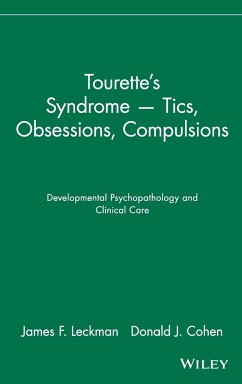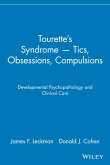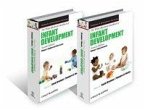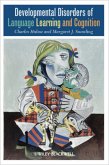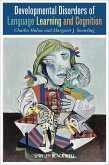James F Leckman, Donald J CohenDevelopmental Psychopathology and Clinical Care
Tourette's Syndrome -- Tics, Obsessions, Compulsions
Developmental Psychopathology and Clinical Care
Herausgeber: Cohen, Donald J.; Leckman, James F.
James F Leckman, Donald J CohenDevelopmental Psychopathology and Clinical Care
Tourette's Syndrome -- Tics, Obsessions, Compulsions
Developmental Psychopathology and Clinical Care
Herausgeber: Cohen, Donald J.; Leckman, James F.
- Gebundenes Buch
- Merkliste
- Auf die Merkliste
- Bewerten Bewerten
- Teilen
- Produkt teilen
- Produkterinnerung
- Produkterinnerung
Früher wurde das Tourette-Syndrom (TS) als seltene Störung betrachtet; mittlerweile jedoch wurde erkannt, daß TS häufig in der Kindheit beginnt. Man weiß jetzt auch, daß die Anfälligkeit für TS über Generationen hinweg vererbt wird. Diagnose, Genetik, Phänomenologie, Geschichte und Behandlung von TS werden hier dargestellt, ausgehend von einem einmaligen Ansatz, der Beziehungen zwischen der Störung und dem normalen Entwicklungsweg herstellt. (8/98)
Andere Kunden interessierten sich auch für
![Tourette's Syndrome -- Tics, Obsessions, Compulsions Tourette's Syndrome -- Tics, Obsessions, Compulsions]() James F LeckmanTourette's Syndrome -- Tics, Obsessions, Compulsions126,99 €
James F LeckmanTourette's Syndrome -- Tics, Obsessions, Compulsions126,99 €![The Wiley-Blackwell Handbook of Infant Development, 2 Volume Set The Wiley-Blackwell Handbook of Infant Development, 2 Volume Set]() The Wiley-Blackwell Handbook of Infant Development, 2 Volume Set488,99 €
The Wiley-Blackwell Handbook of Infant Development, 2 Volume Set488,99 €![Developmental Disorders of Language Learning and Cognition Developmental Disorders of Language Learning and Cognition]() Margaret J. SnowlingDevelopmental Disorders of Language Learning and Cognition153,99 €
Margaret J. SnowlingDevelopmental Disorders of Language Learning and Cognition153,99 €![Developmental Disorders of Language Learning and Cognition Developmental Disorders of Language Learning and Cognition]() Charles HulmeDevelopmental Disorders of Language Learning and Cognition71,99 €
Charles HulmeDevelopmental Disorders of Language Learning and Cognition71,99 €![Einfluss der Covid-19-Pandemie auf psychische Störungen von Kindern und Jugendlichen Einfluss der Covid-19-Pandemie auf psychische Störungen von Kindern und Jugendlichen]() Denis PyttelEinfluss der Covid-19-Pandemie auf psychische Störungen von Kindern und Jugendlichen17,95 €
Denis PyttelEinfluss der Covid-19-Pandemie auf psychische Störungen von Kindern und Jugendlichen17,95 €![Kinderalltag Kinderalltag]() Heidi KellerKinderalltag44,99 €
Heidi KellerKinderalltag44,99 €![Psychologie des Kinderspiels Psychologie des Kinderspiels]() Hans MogelPsychologie des Kinderspiels64,99 €
Hans MogelPsychologie des Kinderspiels64,99 €-
-
-
Früher wurde das Tourette-Syndrom (TS) als seltene Störung betrachtet; mittlerweile jedoch wurde erkannt, daß TS häufig in der Kindheit beginnt. Man weiß jetzt auch, daß die Anfälligkeit für TS über Generationen hinweg vererbt wird. Diagnose, Genetik, Phänomenologie, Geschichte und Behandlung von TS werden hier dargestellt, ausgehend von einem einmaligen Ansatz, der Beziehungen zwischen der Störung und dem normalen Entwicklungsweg herstellt. (8/98)
Hinweis: Dieser Artikel kann nur an eine deutsche Lieferadresse ausgeliefert werden.
Hinweis: Dieser Artikel kann nur an eine deutsche Lieferadresse ausgeliefert werden.
Produktdetails
- Produktdetails
- Verlag: Wiley & Sons
- 2nd edition
- Seitenzahl: 600
- Erscheinungstermin: 9. November 1998
- Englisch
- Abmessung: 240mm x 161mm x 37mm
- Gewicht: 1162g
- ISBN-13: 9780471160373
- ISBN-10: 0471160377
- Artikelnr.: 13795005
- Herstellerkennzeichnung
- Libri GmbH
- Europaallee 1
- 36244 Bad Hersfeld
- gpsr@libri.de
- Verlag: Wiley & Sons
- 2nd edition
- Seitenzahl: 600
- Erscheinungstermin: 9. November 1998
- Englisch
- Abmessung: 240mm x 161mm x 37mm
- Gewicht: 1162g
- ISBN-13: 9780471160373
- ISBN-10: 0471160377
- Artikelnr.: 13795005
- Herstellerkennzeichnung
- Libri GmbH
- Europaallee 1
- 36244 Bad Hersfeld
- gpsr@libri.de
JAMES F. LECKMAN, MD, is Neison Harris Professor of Child Psychiatry and Pediatrics at the Yale Child Study Center. DONALD J. COHEN, MD, is founder of the renowned clinical and scientific research programs for Tourette's Syndrome at the Yale Child Study Center. He is well known for his clinical expertise and breadth of understanding. Dr. Cohen has served as the Director of the Child Study Center since 1983.
INDIVIDUALS, SYMPTOMS, AND DIAGNOSES.Tics and Tic Disorders (J. Leckman, et al.).Obsessive-Compulsive Disorder, Anxiety, and Depression (R. King, et al.).Phenomenology and Natural History of Tic-Related ADHD and Learning Disabilities (J. Walkup, et al.).Neuropsychological Findings (R. Schultz, et al.).Peer Acceptance and Adaptive Functioning (E. Dykens, et al.).Differential Diagnosis (K. Towbin, et al.).Beyond the Diagnosis-Darwinian Perspectives on Pathways to Successful Adaptation (J. Leckman&D. Cohen).CAUSES AND DETERMINANTS.Evolving Models of Pathogenesis (J. Leckman&D. Cohen).Epidemiological Studies (A. Zohar, et al.).Genetic Vulnerability (D. Pauls, et al.).Environmental Risk and Protective Factors (B. Peterson, et al.).Neuroanatomical Circuitry (B. Peterson, et al.).Neurochemical and Neuropeptide Systems (G. Anderson, et al.).PARTNERSHIPS FOR MAKING THE BEST OF TOURETTE'S.Yale Approach to Assessment and Treatment (J. Leckman, et al.).Selection and Use of Diagnostic and Clinical Rating Instruments (L. Scahill, et al.).Comprehensive Psychological and Educational Assessments (A. Carter, et al.).Psychosocial and Behavioral Treatments (R. King, et al.).Recommendations for Teachers (A. Carter, et al.).Pharmacological and Other Somatic Approaches to Treatment (L. Carpenter, et al.).Role of Voluntary Organizations in Clinical Care, Research, and Public Policy (K. Taubert).Appendices.References.Indexes.
Introduction: The Self under Siege (D. Cohen and J. Leckman).
SECTION ONE: INDIVIDUALS, SYMPTOMS, AND DIAGNOSES.
Tics and Tic Disorders (J. Leckman, et al.).
Obsessive-Compulsive Disorder, Anxiety, and Depression (R. King, et al.).
Phenomenology and Natural History of Tic-Related ADHD and Learning
Disabilities (J. Walkup, et al.).
Neuropsychological Findings (R. Schultz, et al.).
Peer Acceptance and Adaptive Functioning (E. Dykens, et al.).
Differential Diagnosis (K. Towbin, et al.).
Beyond the Diagnosis--Darwinian Perspectives on Pathways to Successful
Adaptation (J. Leckman & D. Cohen).
SECTION TWO: CAUSES AND DETERMINANTS.
Evolving Models of Pathogenesis (J. Leckman & D. Cohen).
Epidemiological Studies (A. Zohar, et al.).
Genetic Vulnerability (D. Pauls, et al.).
Environmental Risk and Protective Factors (B. Peterson, et al.).
Neuroanatomical Circuitry (B. Peterson, et al.).
Neurochemical and Neuropeptide Systems (G. Anderson, et al.).
SECTION THREE: PARTNERSHIPS FOR MAKING THE BEST OF TOURETTE'S.
Yale Approach to Assessment and Treatment (J. Leckman, et al.).
Selection and Use of Diagnostic and Clinical Rating Instruments (L.
Scahill, et al.).
Comprehensive Psychological and Educational Assessments (A. Carter, et
al.).
Psychosocial and Behavioral Treatments (R. King, et al.).
Recommendations for Teachers (A. Carter, et al.).
Pharmacological and Other Somatic Approaches to Treatment (L. Carpenter, et
al.).
Role of Voluntary Organizations in Clinical Care, Research, and Public
Policy (K. Taubert).
AppendiX 1.
Appendix 2.
References.
Author Index.
Subject Index.
SECTION ONE: INDIVIDUALS, SYMPTOMS, AND DIAGNOSES.
Tics and Tic Disorders (J. Leckman, et al.).
Obsessive-Compulsive Disorder, Anxiety, and Depression (R. King, et al.).
Phenomenology and Natural History of Tic-Related ADHD and Learning
Disabilities (J. Walkup, et al.).
Neuropsychological Findings (R. Schultz, et al.).
Peer Acceptance and Adaptive Functioning (E. Dykens, et al.).
Differential Diagnosis (K. Towbin, et al.).
Beyond the Diagnosis--Darwinian Perspectives on Pathways to Successful
Adaptation (J. Leckman & D. Cohen).
SECTION TWO: CAUSES AND DETERMINANTS.
Evolving Models of Pathogenesis (J. Leckman & D. Cohen).
Epidemiological Studies (A. Zohar, et al.).
Genetic Vulnerability (D. Pauls, et al.).
Environmental Risk and Protective Factors (B. Peterson, et al.).
Neuroanatomical Circuitry (B. Peterson, et al.).
Neurochemical and Neuropeptide Systems (G. Anderson, et al.).
SECTION THREE: PARTNERSHIPS FOR MAKING THE BEST OF TOURETTE'S.
Yale Approach to Assessment and Treatment (J. Leckman, et al.).
Selection and Use of Diagnostic and Clinical Rating Instruments (L.
Scahill, et al.).
Comprehensive Psychological and Educational Assessments (A. Carter, et
al.).
Psychosocial and Behavioral Treatments (R. King, et al.).
Recommendations for Teachers (A. Carter, et al.).
Pharmacological and Other Somatic Approaches to Treatment (L. Carpenter, et
al.).
Role of Voluntary Organizations in Clinical Care, Research, and Public
Policy (K. Taubert).
AppendiX 1.
Appendix 2.
References.
Author Index.
Subject Index.
INDIVIDUALS, SYMPTOMS, AND DIAGNOSES.Tics and Tic Disorders (J. Leckman, et al.).Obsessive-Compulsive Disorder, Anxiety, and Depression (R. King, et al.).Phenomenology and Natural History of Tic-Related ADHD and Learning Disabilities (J. Walkup, et al.).Neuropsychological Findings (R. Schultz, et al.).Peer Acceptance and Adaptive Functioning (E. Dykens, et al.).Differential Diagnosis (K. Towbin, et al.).Beyond the Diagnosis-Darwinian Perspectives on Pathways to Successful Adaptation (J. Leckman&D. Cohen).CAUSES AND DETERMINANTS.Evolving Models of Pathogenesis (J. Leckman&D. Cohen).Epidemiological Studies (A. Zohar, et al.).Genetic Vulnerability (D. Pauls, et al.).Environmental Risk and Protective Factors (B. Peterson, et al.).Neuroanatomical Circuitry (B. Peterson, et al.).Neurochemical and Neuropeptide Systems (G. Anderson, et al.).PARTNERSHIPS FOR MAKING THE BEST OF TOURETTE'S.Yale Approach to Assessment and Treatment (J. Leckman, et al.).Selection and Use of Diagnostic and Clinical Rating Instruments (L. Scahill, et al.).Comprehensive Psychological and Educational Assessments (A. Carter, et al.).Psychosocial and Behavioral Treatments (R. King, et al.).Recommendations for Teachers (A. Carter, et al.).Pharmacological and Other Somatic Approaches to Treatment (L. Carpenter, et al.).Role of Voluntary Organizations in Clinical Care, Research, and Public Policy (K. Taubert).Appendices.References.Indexes.
Introduction: The Self under Siege (D. Cohen and J. Leckman).
SECTION ONE: INDIVIDUALS, SYMPTOMS, AND DIAGNOSES.
Tics and Tic Disorders (J. Leckman, et al.).
Obsessive-Compulsive Disorder, Anxiety, and Depression (R. King, et al.).
Phenomenology and Natural History of Tic-Related ADHD and Learning
Disabilities (J. Walkup, et al.).
Neuropsychological Findings (R. Schultz, et al.).
Peer Acceptance and Adaptive Functioning (E. Dykens, et al.).
Differential Diagnosis (K. Towbin, et al.).
Beyond the Diagnosis--Darwinian Perspectives on Pathways to Successful
Adaptation (J. Leckman & D. Cohen).
SECTION TWO: CAUSES AND DETERMINANTS.
Evolving Models of Pathogenesis (J. Leckman & D. Cohen).
Epidemiological Studies (A. Zohar, et al.).
Genetic Vulnerability (D. Pauls, et al.).
Environmental Risk and Protective Factors (B. Peterson, et al.).
Neuroanatomical Circuitry (B. Peterson, et al.).
Neurochemical and Neuropeptide Systems (G. Anderson, et al.).
SECTION THREE: PARTNERSHIPS FOR MAKING THE BEST OF TOURETTE'S.
Yale Approach to Assessment and Treatment (J. Leckman, et al.).
Selection and Use of Diagnostic and Clinical Rating Instruments (L.
Scahill, et al.).
Comprehensive Psychological and Educational Assessments (A. Carter, et
al.).
Psychosocial and Behavioral Treatments (R. King, et al.).
Recommendations for Teachers (A. Carter, et al.).
Pharmacological and Other Somatic Approaches to Treatment (L. Carpenter, et
al.).
Role of Voluntary Organizations in Clinical Care, Research, and Public
Policy (K. Taubert).
AppendiX 1.
Appendix 2.
References.
Author Index.
Subject Index.
SECTION ONE: INDIVIDUALS, SYMPTOMS, AND DIAGNOSES.
Tics and Tic Disorders (J. Leckman, et al.).
Obsessive-Compulsive Disorder, Anxiety, and Depression (R. King, et al.).
Phenomenology and Natural History of Tic-Related ADHD and Learning
Disabilities (J. Walkup, et al.).
Neuropsychological Findings (R. Schultz, et al.).
Peer Acceptance and Adaptive Functioning (E. Dykens, et al.).
Differential Diagnosis (K. Towbin, et al.).
Beyond the Diagnosis--Darwinian Perspectives on Pathways to Successful
Adaptation (J. Leckman & D. Cohen).
SECTION TWO: CAUSES AND DETERMINANTS.
Evolving Models of Pathogenesis (J. Leckman & D. Cohen).
Epidemiological Studies (A. Zohar, et al.).
Genetic Vulnerability (D. Pauls, et al.).
Environmental Risk and Protective Factors (B. Peterson, et al.).
Neuroanatomical Circuitry (B. Peterson, et al.).
Neurochemical and Neuropeptide Systems (G. Anderson, et al.).
SECTION THREE: PARTNERSHIPS FOR MAKING THE BEST OF TOURETTE'S.
Yale Approach to Assessment and Treatment (J. Leckman, et al.).
Selection and Use of Diagnostic and Clinical Rating Instruments (L.
Scahill, et al.).
Comprehensive Psychological and Educational Assessments (A. Carter, et
al.).
Psychosocial and Behavioral Treatments (R. King, et al.).
Recommendations for Teachers (A. Carter, et al.).
Pharmacological and Other Somatic Approaches to Treatment (L. Carpenter, et
al.).
Role of Voluntary Organizations in Clinical Care, Research, and Public
Policy (K. Taubert).
AppendiX 1.
Appendix 2.
References.
Author Index.
Subject Index.

